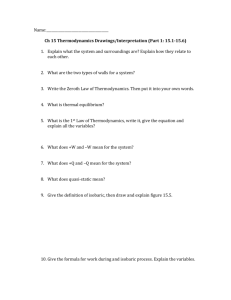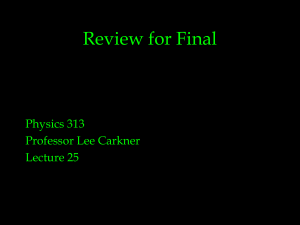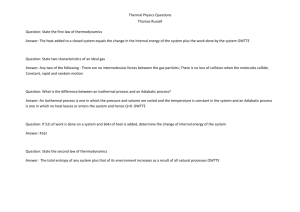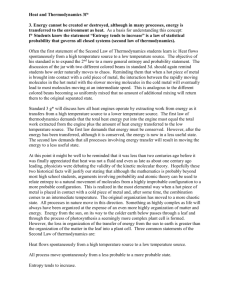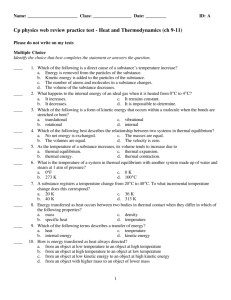Unit 5 Practice Test: Thermodynamics Name:
advertisement
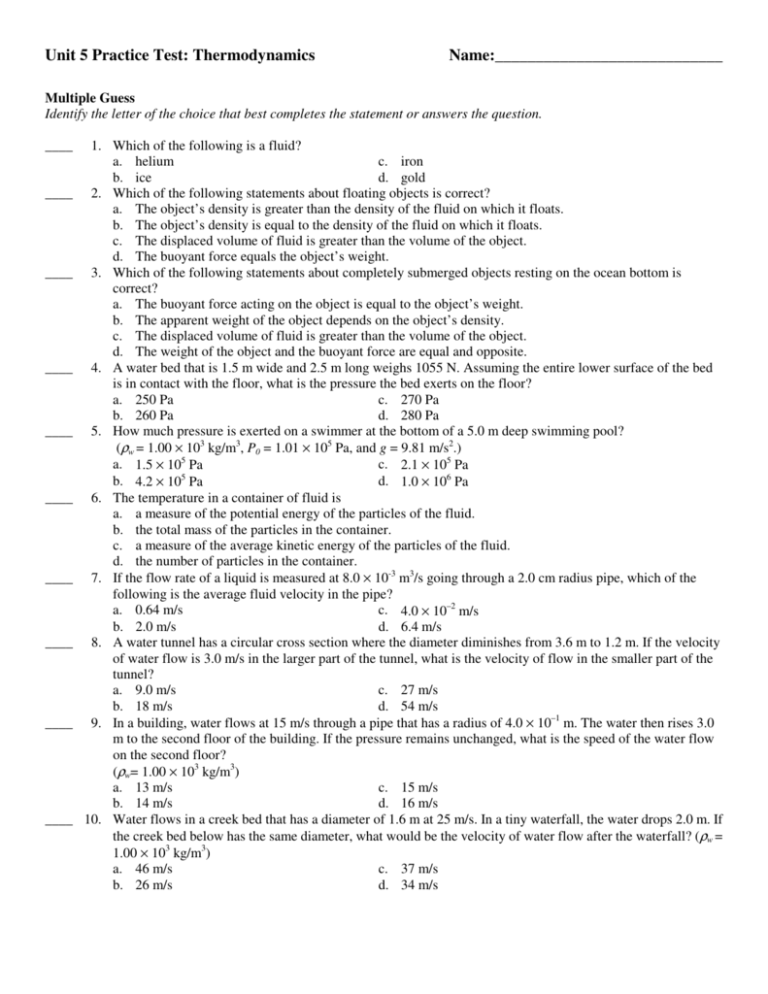
Unit 5 Practice Test: Thermodynamics Name:____________________________ Multiple Guess Identify the letter of the choice that best completes the statement or answers the question. ____ ____ ____ ____ ____ ____ ____ ____ ____ ____ 1. Which of the following is a fluid? a. helium c. iron b. ice d. gold 2. Which of the following statements about floating objects is correct? a. The object’s density is greater than the density of the fluid on which it floats. b. The object’s density is equal to the density of the fluid on which it floats. c. The displaced volume of fluid is greater than the volume of the object. d. The buoyant force equals the object’s weight. 3. Which of the following statements about completely submerged objects resting on the ocean bottom is correct? a. The buoyant force acting on the object is equal to the object’s weight. b. The apparent weight of the object depends on the object’s density. c. The displaced volume of fluid is greater than the volume of the object. d. The weight of the object and the buoyant force are equal and opposite. 4. A water bed that is 1.5 m wide and 2.5 m long weighs 1055 N. Assuming the entire lower surface of the bed is in contact with the floor, what is the pressure the bed exerts on the floor? a. 250 Pa c. 270 Pa b. 260 Pa d. 280 Pa 5. How much pressure is exerted on a swimmer at the bottom of a 5.0 m deep swimming pool? (ρw = 1.00 × 103 kg/m3, P0 = 1.01 × 105 Pa, and g = 9.81 m/s2.) a. 1.5 × 105 Pa c. 2.1 × 105 Pa 5 b. 4.2 × 10 Pa d. 1.0 × 106 Pa 6. The temperature in a container of fluid is a. a measure of the potential energy of the particles of the fluid. b. the total mass of the particles in the container. c. a measure of the average kinetic energy of the particles of the fluid. d. the number of particles in the container. 7. If the flow rate of a liquid is measured at 8.0 × 10-3 m3/s going through a 2.0 cm radius pipe, which of the following is the average fluid velocity in the pipe? a. 0.64 m/s c. 4.0 × 10–2 m/s b. 2.0 m/s d. 6.4 m/s 8. A water tunnel has a circular cross section where the diameter diminishes from 3.6 m to 1.2 m. If the velocity of water flow is 3.0 m/s in the larger part of the tunnel, what is the velocity of flow in the smaller part of the tunnel? a. 9.0 m/s c. 27 m/s b. 18 m/s d. 54 m/s 9. In a building, water flows at 15 m/s through a pipe that has a radius of 4.0 × 10–1 m. The water then rises 3.0 m to the second floor of the building. If the pressure remains unchanged, what is the speed of the water flow on the second floor? (ρw= 1.00 × 103 kg/m3) a. 13 m/s c. 15 m/s b. 14 m/s d. 16 m/s 10. Water flows in a creek bed that has a diameter of 1.6 m at 25 m/s. In a tiny waterfall, the water drops 2.0 m. If the creek bed below has the same diameter, what would be the velocity of water flow after the waterfall? (ρw = 1.00 × 103 kg/m3) a. 46 m/s c. 37 m/s b. 26 m/s d. 34 m/s ____ 11. A person is standing near the edge of a railroad track when a high-speed train passes. The person tends to be a. pushed away from the train. c. pushed upward into the air. b. pulled toward the train. d. unaffected by the train. ____ 12. At a constant volume, an ideal gas is heated from 348 K to 423 K. If the original pressure in the tank was 1.51 × 105 Pa and the volume does not change, what is the new pressure? c. 1.84 × 105 Pa a. 1.24 × 105 Pa 4 d. 4.97 × 102 Pa b. 9.75 × 10 Pa ____ 13. At a constant pressure, 6.00 m3 of an ideal gas at 348 K is cooled until its volume is halved. What is the new temperature of the gas? a. 174 K c. 19.3 K b. 696 K d. 116 K ____ 14. The initial volume, pressure, and temperature of an ideal gas in a tank are 15 L, 2.0 atm, and 310 K, respectively. If the pressure increases to 3.5 atm and the temperature increases to 430 K, what is the final volume of the gas? a. 12 L c. 3.1 L b. 6.2 L d. 9.4 L ____ 15. What happens to the internal energy of an ideal gas when it is heated from 0°C to 4°C? a. It increases. c. It remains constant. b. It decreases. d. It is impossible to determine. ____ 16. Which of the following best describes the relationship between two systems in thermal equilibrium? a. No net energy is exchanged. c. The masses are equal. b. The volumes are equal. d. The velocity is zero. ____ 17. Energy transferred as heat always moves from an object a. at high temperature to an object at low temperature. b. at low temperature to an object at high temperature. c. at low kinetic energy to an object at high kinetic energy. d. of higher mass to an object of lower mass. ____ 18. Which of the following terms describes a transfer of energy? a. heat c. temperature b. internal energy d. kinetic energy ____ 19. A pitcher of iced tea is made by adding ice to 1.8 kg of hot tea with an initial temperature of 80.0°C. How many kilograms of ice, which has an initial temperature of 0.0°C, are required to bring the mixture to 10.0°C? (Lf = 3.3 × 105 J/kg) a. 1.8 kg c. 1.4 kg b. 1.6 kg d. 1.2 kg ____ 20. How much heat energy must be removed from 0.10 kg of oxygen with a temperature of 22.0°C in order for the oxygen to liquefy at –183°C? (c0 = 9.13 × 10–1 J/g•°C and Lv = 213 J/g.) a. 5.71 × 104 J c. 1.81 × 104 J 4 b. 4.00 × 10 J d. 9.56 × 103 J D ____ 21. At what point on the figure above is the amount of energy transferred as heat approximately 4.19 × 103 J? a. A c. C b. B d. D ____ 22. At what point on the figure above does the substance undergo a phase change? a. A c. C b. B d. E ____ 23. The use of fiberglass insulation in the outer walls of a building is intended to minimize heat transfer through what process? a. conduction c. convection b. radiation d. vaporization ____ 24. If an ideal gas does positive work on its surroundings, a. the temperature of the gas increases. c. the pressure of the gas increases. b. the volume of the gas increases. d. the internal energy of the gas decreases. ____ 25. A 2 mol ideal gas system is maintained at a constant volume of 4 L. If the pressure is constant, how much work is done by the system? a. 0 J c. 8 J b. 5 J d. 30 J ____ 26. Air cools as it escapes from a diver’s compressed air tank. What kind of process is this? a. isothermal c. adiabatic b. isobaric d. isovolumetric ____ 27. Which of the following is a thermodynamic process during which work is done on or by the system but no energy is transferred to or from the system as heat? a. adiabatic process c. isovolumetric process b. isothermal process d. isobaric process ____ 28. Which of the following processes for an ideal gas system has an unchanging internal energy and a heat intake that corresponds to the value of the work done by the system? a. isothermal process c. adiabatic process b. isobaric process d. isovolumetric process ____ 29. Which of the following is a thermodynamic process that takes place at a constant temperature and in which the internal energy of a system remains unchanged? a. adiabatic process c. isovolumetric process b. isothermal process d. isobaric process ____ 30. Which of the following is a thermodynamic process that takes place at constant volume so that no work is done on or by the system? a. adiabatic process c. isovolumetric process b. isothermal process d. isobaric process ____ 31. In an isovolumetric process by an ideal gas, the system’s heat gain is equivalent to a change in which of the following? a. temperature c. pressure b. volume d. internal energy ____ 32. During an isovolumetric process, which of the following does not change? a. volume c. internal energy b. temperature d. pressure ____ 33. According to the first law of thermodynamics, the difference between energy transferred to or from a system as heat and energy transferred to or from a system by work is equivalent to which of the following? a. entropy change c. temperature change b. internal energy change d. specific heat ____ 34. How is conservation of internal energy expressed for an isovolumetric system? a. Q = W = 0, so ∆U = 0 and Ui = Uf b. Q = 0, so ∆U = –W c. ∆T = 0, so ∆U = 0; therefore, ∆U = Q – W = 0, or Q = W d. ∆V = 0, so P∆V = 0 and W = 0; therefore, ∆U = Q ____ 35. How is conservation of internal energy expressed for an isothermal system? a. Q = W = 0, so ∆U = 0 and Ui = Uf b. Q = 0, so ∆U = –W c. ∆T = 0, so ∆U = 0; therefore, ∆U = Q – W = 0, or Q = W d. ∆V = 0, so P∆V = 0 and W = 0; therefore, ∆U = Q ____ 36. A 4 mol ideal gas system undergoes an adiabatic process in which it expands and does 20 J of work on its environment. What is its change in internal energy? a. –20 J c. 0 J b. –5 J d. 20 J ____ 37. A total of 165 J of work is done on a gaseous refrigerant as it undergoes compression. If the internal energy of the gas increases by 123 J during the process, what is the total amount of energy transferred as heat? a. –42 J c. –288 J b. 42 J d. 288 J ____ 38. The internal energy of a system is initially 63 J. A total of 71 J of energy is added to the system as heat while the system does 59 J of work. What is the system’s final internal energy? a. 51 J c. 67 J b. 75 J d. 190 J ____ 39. Over several cycles, a refrigerator does 2.67 × 104 J of work on the refrigerant. The refrigerant, in turn, removes 7.49 × 104 J as heat from the air inside the refrigerator. How much work is done on the air inside the refrigerator? a. 0.00 J c. 6.38 × 104 J 4 b. 4.92 × 10 J d. 9.84 × 104 J ____ 40. An engine absorbs 2150 J as heat from a hot reservoir and gives off 750 J as heat to a cold reservoir during each cycle. How much work is done during each cycle? a. 750 J c. 2150 J b. 1400 J d. 2900 J ____ 41. According to the second law of thermodynamics, the heat received by a heat engine operating in a complete cycle from a high-temperature reservoir a. must be completely converted to work. b. equals the entropy increase. c. can be completely converted to internal energy. d. cannot be completely converted to work. ____ 42. A heat engine performs 2000.0 J of net work while adding 5000.0 J of heat to the cold-temperature reservoir. What is the efficiency of the engine? a. 0.714 c. 0.400 b. 0.600 d. 0.286 ____ 43. An engine adds 75 000 J of energy as heat and removes 15 000 J of energy as heat. What is the engine’s efficiency? a. 0.80 c. 0.50 b. 0.20 d. 0.60 ____ 44. Imagine you could observe the individual atoms that make up a piece of matter and that you observe the motion of the atoms becoming more orderly. What can you assume about the system? a. Its entropy is increasing. b. Its entropy is decreasing. c. It is gaining thermal energy. d. Positive work is being done on the system. ____ 45. When an egg is broken and scrambled, the entropy of the system a. increases, and the total entropy of the universe increases. b. decreases, and the total entropy of the universe increases. c. increases, and the total entropy of the universe decreases. d. decreases, and the total entropy of the universe decreases. Short Answer 46. What determines whether an object will sink or float? 47. Describe how temperature is related to the kinetic energy of the molecules of the gas in the figure above. D 48. In the figure above, what happens to the ice at 0°C? 49. In the figure above, what happens to the ice at 100°C? 50. Why is air an effective thermal insulator for the body? 51. Why would covering most of the body keep a person cool in the desert? 52. What is true of the internal energy of an isolated system? 53. According to the first law of thermodynamics, how can the internal energy of a system be increased? 54. State the second law of thermodynamics. 55. School office records are filed in folders in alphabetical order. Does this system have high or low entropy? 56. A glass beaker falls to the floor and breaks. Does this system have high or low entropy? Problems 57. An air-filled balloon with a mass of 3.0 g is placed in a pool of water. What is the buoyant force acting on the balloon if the density of air is 1.29 × 10–3 g/cm3 and the density of water is 1.00 g/cm3? 58. An ice cube is placed in a glass of water. The cube is 2.0 cm on each side and has a density of 0.917 g/cm3. What is the buoyant force on the ice? 59. The temperature of an oxygen tank is at 261 K, and the temperature of a nitrogen tank is 11°C. Which container has the higher temperature and by how many degrees? 60. A mixture of 30.2 g of sand and 87.7 g of water has a temperature of 12.1°C. What mass of water at 85.8°C must be added to raise the final temperature of the mixture to 29.3°C? (cw = 4.19 J/g•°C and cs = 2.01 J/g•°C) Unit 5 Practice Test: Thermodynamics Answer Section MULTIPLE GUESS 1. 2. 3. 4. 5. 6. 7. 8. 9. 10. 11. 12. 13. 14. 15. 16. 17. 18. 19. 20. 21. 22. 23. A D B D A C D C A B B C A A A A A A C B C B A 24. 25. 26. 27. 28. 29. 30. 31. 32. 33. 34. 35. 36. 37. 38. 39. 40. 41. 42. 43. 44. 45. B A C A A B C D A B D C A A B A B D D A A A SHORT ANSWER 46. The net force, or the apparent weight acting on the object, determines whether an object will sink or float. 47. When energy is added to the gas, the kinetic energy of the molecules increases. The temperature increases because temperature is proportional to the kinetic energy of the molecules. 48. The ice begins to melt and change into water. 49. The temperature stops rising, and the water turns into steam. 50. Air is an extremely poor thermal conductor. A thin layer of air near the skin provides a barrier from energy transfer. 51. Covering the body would protect it from direct sunlight and prevent excessive loss of body water through evaporation. 52. According to the first law of thermodynamics, no energy is transferred to or from an isolated system. 53. Energy can be transferred to the system as heat or by work. 54. No machine can be made that only absorbs energy as heat and then entirely transfers the energy out of the engine as an equal amount of work. 55. low entropy 56. high entropy PROBLEMS 57. 58. 23 N 7.2 × 10–2 N 59. 60. The nitrogen container is at the higher temperature by 23 K or 23°C. 31.1 g
